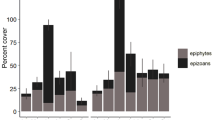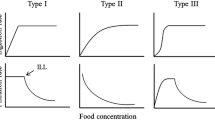Abstract
The susceptibility of native and non-native populations of the red alga Gracilaria vermiculophylla to fouling was compared in common garden experiments. Native and non-native algae were enclosed into dialysis membrane tubes, and the tubes were exposed to natural fouling. Fouling on the outside of the tubes was mediated by chemical compounds excreted by G. vermiculophylla that diffused through the membranes. Fouling pressure was significantly higher in the Kiel Fjord (non-native range) than in Akkeshi Bay (native range), but, at both sites, tubes containing non-native G. vermiculophylla were less fouled than those with native conspecifics. This is the first in situ evidence that susceptibility to fouling differs between native and non-native populations of an aquatic organism. The technique of enclosing organisms into dialysis tubes represents a simple, efficient and accurate way to test chemical antifouling defenses and could possibly be applied to other organisms.






Similar content being viewed by others
References
Bach CE, Hazlett BA, Rittschof D (2006) Sex-specific differences and the role of predation in the interaction between the hermit crab, Pagurus longicarpus, and its epibiont, Hydractinia symbiolongicarpus. J Exp Mar Biol Ecol 333:181–189. doi:10.1016/j.jembe.2005.12.003
Bellorin AM, Oliveira MC, Oliveira EC (2004) Gracilaria vermiculophylla: a western Pacific species of Gracilariaceae (Rhodophyta) first recorded from the eastern Pacific. Phycol Res 52:69–79. doi:10.1111/j.1440-1835.2004.tb00317.x
Blossey B, Nötzold R (1995) Evolution of increased competitive ability in invasive nonindigenous plants: a hypothesis. J Ecol 83:887–889. doi:10.2307/2261425
Buschbaum C, Buschbaum G, Schrey I, Thieltges DW (2007) Shell-boring polychaetes affect gastropod shell strength and crab predation. Mar Ecol Prog Ser 329:123–130. doi:10.3354/meps329123
Buschmann AH, Gómez P (1993) Interaction mechanisms between Gracilaria chilensis (Rhodophyta) and epiphytes. Hydrobiologia 261:345–351
Cacabelos E, Olabarria C, Incera M, Troncoso JS (2010) Do grazers prefer invasive seaweeds? J Exp Mar Biol Ecol 393:182–187
Callaway RM, Ridenour WM (2004) Novel weapons: invasive success and the evolution of increased competitive ability. Front Ecol Environ 2:436–443
Colautti RI, Ricciardi A, Grigorovich IA, MacIsaac HJ (2004) Is invasion success explained by the enemy release hypothesis? Ecol Lett 7:721–733. doi:10.1111/j.1461-0248.2004.00616.x
Costerton JW, Cheng KJ, Geesey GG, Ladd TI, Nickel JC, Dasgupta M, Marrie TJ (1987) Bacterial biofilms in nature and disease. Annu Rev Microbiol 41:435–464
Crimaldi JP, Thompson JK, Rosman JH, Lowe RJ, Koseff JR (2002) Hydrodynamics of larval settlement: the influence of turbulent stress events at potential recruitment sites. Limnol Oceanogr 47:1137–1151
da Gama BAP, Plouguerné E, Pereira RC (2014) The antifouling defence mechanisms of marine macroalgae. In: Bourgougnon N (ed) Advances in botanical research. Academic Press, Oxford, pp 413–440
Freshwater DW, Montgomery F, Greene JK, Hamner RM, Williams M, Whitfield PE (2006) Distribution and identification of an invasive Gracilaria species that is hampering commercial fishing operations in southeastern North Carolina, USA. Biol Invasions 8:631–637. doi:10.1007/s10530-005-1809-5
Guillemin ML, Akki SA, Givernaud T, Mouradi A, Valero M, Destombe C (2008) Molecular characterisation and development of rapid molecular methods to identify species of Gracilariaceae from the Atlantic coast of Morocco. Aquat Bot 89:324–330. doi:10.1016/j.aquabot.2008.03.008
Hammann M, Wang GG, Rickert E, Boo SM, Weinberger F (2013) Invasion success of the seaweed Gracilaria vermiculophylla correlates with low palatability. Mar Ecol Prog Ser 486:93–103. doi:10.3354/meps10361
Hammann M, Rempt M, Pohnert G, Wang G, Boo SM, Weinberger F (2016a) Increased potential for wound activated production of Prostaglandin E-2 and related toxic compounds in non-native populations of Gracilaria vermiculophylla. Harmful Algae 51:81–88. doi:10.1016/j.hal.2015.11.009
Hammann M, Wang GG, Boo SM, Aguilar-Rosas LE, Weinberger F (2016b) Selection of heat-shock resistance traits during the invasion of the seaweed Gracilaria vermiculophylla. Mar Biol 163:104. doi:10.1007/s00227-016-2881-3
Hemmi A, Mäkinen A, Jormalainen V, Honkanen T (2005) Responses of growth and phlorotannins in Fucus vesiculosus to nutrient enrichment and herbivory. Aquat Ecol 39:201–211
Honkanen T, Jormalainen V (2005) Genotypic variation in tolerance and resistance to fouling in the brown alga Facus vesiculosus. Oecologia 144:196–205. doi:10.1007/00442-005-0053-0
Johnson CR, Chapman ARO (2007) Seaweed invasions: introduction and scope. Bot Mar 50:321–325. doi:10.1515/bot.2007.037
Keane RM, Crawley MJ (2002) Exotic plant invasions and the enemy release hypothesis. Trends Ecol Evol 17:164–170
Koehl MAR, Crimaldi JP, Dombroski DE (2013) Wind chop and ship wakes determine hydrodynamic stresses on larvae settling on different microhabitats in fouling communities. Mar Ecol Prog Ser 479:47–62. doi:10.3354/meps10193
Korpinen S, Honkanen T, Vesakoski O, Hemmi A, Koivikko R, Loponen J, Jormalainen V (2007) Macroalgal communities face the challenge of changing biotic interactions: review with focus on the Baltic Sea. Ambio 36:203–211. doi:10.1579/0044-7447(2007)36[203:mcftco]2.0.co;2
Krueger-Hadfield SA, Kollars NM, Byers JE, Greig TW, Hammann M, Murray DC, Murren CJ, Strand AE, Terada R, Weinberger F, Sotka EE (2016) Invasion of novel habitats uncouples haplo-diplontic life cycles. Mol Ecol 25:3801–3816. doi:10.1111/mec.13718
Lake JC, Leishman MR (2004) Invasion success of exotic in natural ecosystems: the role of disturbance, plant attributes and freedom from herbivores. Biol Conserv 117:215–226. doi:10.1016/s0006-3207(03)00294-5
Leonardi PI, Miravalles AB, Faugeron S, Flores V, Beltrán J, Correa JA (2006) Diversity, phenomenology and epidemiology of epiphytism in farmed Gracilaria chilensis (Rhodophyta) in northern Chile. Eur J Phycol 41:247–257. doi:10.1080/09670260600645659
Lion U, Wiesemeier T, Weinberger F, Beltrán J, Flores V, Faugeron S, Correa J, Pohnert G (2006) Phospholipases and galactolipases trigger oxylipin-mediated wound-activated defence in the red alga Gracilaria chilensis against epiphytes. ChemBioChem 7:457–462. doi:10.1002/cbic.200500365
Lubchenco J, Olson AM, Brubaker LB, Carpenter SR, Holland MM, Hubbell SP, Levin SA, Macmahon JA, Matson PA, Melillo JM, Mooney HA, Peterson CH, Pulliam HR, Real LA, Regal PJ, Risser PG (1991) The sustainable biosphere initiative: an ecological research agenda: a report from the Ecological Society of America. Ecology 72:371–412. doi:10.2307/2937183
Nejrup LB, Pedersen MF (2012) The effect of temporal variability in salinity on the invasive red alga Gracilaria vermiculophylla. Eur J Phycol 47:254–263. doi:10.1080/09670262.2012.702225
Nyberg CD, Wallentinus I (2009) Long-term survival of an introduced red alga in adverse conditions. Mar Biol Res 5:304–308. doi:10.1080/17451000802428159
Parker JD, Burkepile DE, Hay ME (2006) Opposing effects of native and exotic herbivores on plant invasions. Science 311:1459–1461. doi:10.1126/science.1121407
Paul NA, de Nys R, Steinberg PD (2006a) Chemical defence against bacteria in the red alga Asparagopsis armata: linking structure with function. Mar Ecol Prog Ser 306:87–101. doi:10.3354/meps306087
Paul NA, de Nys R, Steinberg PD (2006b) Seaweed-herbivore interactions at a small scale: direct tests of feeding deterrence by filamentous algae. Mar Ecol Prog Ser 323:1–9. doi:10.3354/meps323001
Rempt M, Weinberger F, Grosser K, Pohnert G (2012) Conserved and species-specific oxylipin pathways in the wound-activated chemical defense of the noninvasive red alga Gracilaria chilensis and the invasive Gracilaria vermiculophylla. Beilstein J Org Chem 8:283–289. doi:10.3762/bjoc.8.30
Rickert E, Karsten U, Pohnert G, Wahl M (2015) Seasonal fluctuations in chemical defenses against macrofouling in Fucus vesiculosus and Fucus serratus from the Baltic Sea. Biofouling 31:363–377. doi:10.1080/08927014.2015.1041020
Rickert E, Lenz M, Barboza FR, Gorb SN, Wahl M (2016) Seasonally fluctuating chemical microfouling control in Fucus vesiculosus and Fucus serratus from the Baltic Sea. Mar Biol 163:203
Roleda MY, Nyberg CD, Wulff A (2012) UVR defense mechanisms in eurytopic and invasive Gracilaria vermiculophylla (Gracilariales, Rhodophyta). Physiol Plant 146:205–216. doi:10.1111/j.1399-3054.2012.01615.x
Saha M, Wahl M (2013) Seasonal variation in the antifouling defence of the temperate brown alga Fucus vesiculosus. Biofouling 29:661–668. doi:10.1080/08927014.2013.795953
Saha M, Wiese J, Weinberger F, Wahl M (2016) Rapid adaptation to controlling new microbial epibionts in the invaded range promotes invasiveness of an exotic seaweed. J Ecol 104:969–978. doi:10.1111/1365-2745.12590
Saunders GW (2009) Routine DNA barcoding of Canadian Gracilariales (Rhodophyta) reveals the invasive species Gracilaria vermiculophylla in British Columbia. Mol Ecol Resour 9:140–150. doi:10.1111/j.1755-0998.2009.02639.x
Schaffelke B, Smith JE, Hewitt CL (2006) Introduced macroalgae—a growing concern. J Appl Phycol 18:529–541. doi:10.1007/s10811-006-9074-2
Sfriso A, Maistro S, Andreoli C, Moro I (2010) First record of Gracilaria vermiculophylla (Gracilariales, Rhodophyta) in the po delta lagoons, Mediterranean sea (Italy). J Phycol 46:1024–1027. doi:10.1111/j.1529-8817.2010.00893.x
Spalding MD, Fox HE, Halpern BS, McManus MA, Molnar J, Allen GR, Davidson N, Jorge ZA, Lombana AL, Lourie SA, Martin KD, McManus E, Molnar J, Recchia CA, Robertson J (2007) Marine ecoregions of the world: a bioregionalization of coastal and shelf areas. Bioscience 57:573–583. doi:10.1641/b570707
Stastny M, Schaffner U, Elle E (2005) Do vigour of introduced populations and escape from specialist herbivores contribute to invasiveness? J Ecol 93:27–37. doi:10.1111/j.1365-2745.2004.00962.x
Streftaris N, Zenetos A, Papathanassiou E (2005) Globalisation in marine ecosystems: the story of non-indigenous marine species across European seas. Oceanogr Mar Biol 43:419–453
Strong JA, Maggs CA, Johnson MP (2009) The extent of grazing release from epiphytism for Sargassum muticum (Phaeophyceae) within the invaded range. J Mar Biol Assoc UK 89:303–314. doi:10.1017/s0025315408003226
Svensson JR, Nylund GM, Cervin G, Toth GB, Pavia H (2013) Novel chemical weapon of an exotic macroalga inhibits recruitment of native competitors in the invaded range. J Ecol 101:140–148. doi:10.1111/1365-2745.12028
Thevanathan R, Nirmala M, Manoharan A, Gangadharan A, Rajarajan R, Dhamothrarn R, Selvaraj S (2000) On the occurrence of nitrogen fixing bacteria as epibacterial flora of some marine green algae. Seaweed Res Utiln 22:189–197
Thomsen MS, McGlathery KJ, Tyler AC (2006) Macroalgal distribution patterns in a shallow, soft-bottom lagoon, with emphasis on the nonnative Gracilaria vermiculophylla and Coldium fragile. Estuar Coast 29:465–473
Tseng CK, Xia BM (1999) On the Gracilaria in the Western Pacific and the southeastern Asia region. Bot Mar 42:209–217. doi:10.1515/bot.1999.024
Vermeij MJA, Smith TB, Dailer ML, Smith CM (2009) Release from native herbivores facilitates the persistence of invasive marine algae: a biogeographical comparison of the relative contribution of nutrients and herbivory to invasion success. Biol Invasions 11:1463–1474. doi:10.1007/s10530-008-9354-7
Vitousek PM, Dantonio CM, Loope LL, Westbrooks R (1996) Biological invasions as global environmental change. Am Sci 84:468–478
Wahl M (1989) Marine epibiosis. I. Fouling and antifouling: some basic aspects. Mar Ecol Prog Ser 58:175–189
Wahl M (2008) Ecological lever and interface ecology: epibiosis modulates the interactions between host and environment. Biofouling 24:427–438
Wahl M, Mark O (1999) The predominantly facultative nature of epibiosis: experimental and observational evidence. Mar Ecol Prog Ser 187:59–66
Wang S, Wang G, Weinberger F, Bian D, Nakaoka M, Lenz M (2016) Anti-epiphyte defences in the red seaweed Gracilaria vermiculophylla: non-native algae are better defended than their native conspecifics. J Ecol. doi:10.1111/1365-2745.12694
Weinberger F, Buchholz B, Karez R, Wahl M (2008) The invasive red alga Gracilaria vermiculophylla in the Baltic Sea: adaptation to brackish water may compensate for light limitation. Aquat Biol 3:251–264. doi:10.3354/ab00083
Wikström SA, Steinarsdóttir MB, Kautsky L, Pavia H (2006) Increased chemical resistance explains low herbivore colonization of introduced seaweed. Oecologia 148:593–601. doi:10.1007/s00442-006-0407-2
Williams SL, Smith JE (2007) A global review of the distribution, taxonomy, and impacts of introduced seaweeds. Annu Rev Ecol Evol Syst 38:327–359. doi:10.1146/annurev.ecolsys.38.091206.095543
Yamamoto K, Endo H, Yoshikawa S, Ohki K, Kamiya M (2013) Various defense ability of four sargassacean algae against the red algal epiphyte Neosiphonia harveyi in Wakasa Bay, Japan. Aquat Bot 105:11–17. doi:10.1016/j.aquabot.2012.10.008
Acknowledgements
S. Wang was supported by a scholarship from the China Scholarship Council (CSC) at GEOMAR—Helmholtz-Zentrum für Ozeanforschung in Kiel. We would like to thank Prof. Dr. Martin Wahl for his valuable support and technical advices for experimental design. We are thankful to Renate Schütt for her great help in epibionts identification and to Nadja Stärck for her technical advices and help with field work preparation. We are very grateful to Dr. Inken Kruse, Dr. Takehisa Yamakita, Haruka Yamaguchi and Carola Schuller for collecting and sending algal samples. We acknowledge: NSF BIO-OCE-1357386.
Author information
Authors and Affiliations
Corresponding author
Ethics declarations
Conflict of interest
The authors declare that they have no conflict of interest.
Funding
This study was funded by the China Scholarship Council (CSC) (Number 201206330050).
Ethical approval
All applicable international, national and/or institutional guidelines for the care and use of animals were followed.
Data accessibility
All experimental data underlying this publication are available from the PANGAEA repository (doi: https://doi.pangaea.de/10.1594/PANGAEA.865280).
Additional information
Responsible Editor: F. Bulleri.
Reviewed by Undisclosed experts.
Electronic supplementary material
Below is the link to the electronic supplementary material.
Rights and permissions
About this article
Cite this article
Wang, S., Weinberger, F., Xiao, L. et al. In situ common garden assays demonstrate increased defense against natural fouling in non-native populations of the red seaweed Gracilaria vermiculophylla . Mar Biol 164, 193 (2017). https://doi.org/10.1007/s00227-017-3226-6
Received:
Accepted:
Published:
DOI: https://doi.org/10.1007/s00227-017-3226-6




